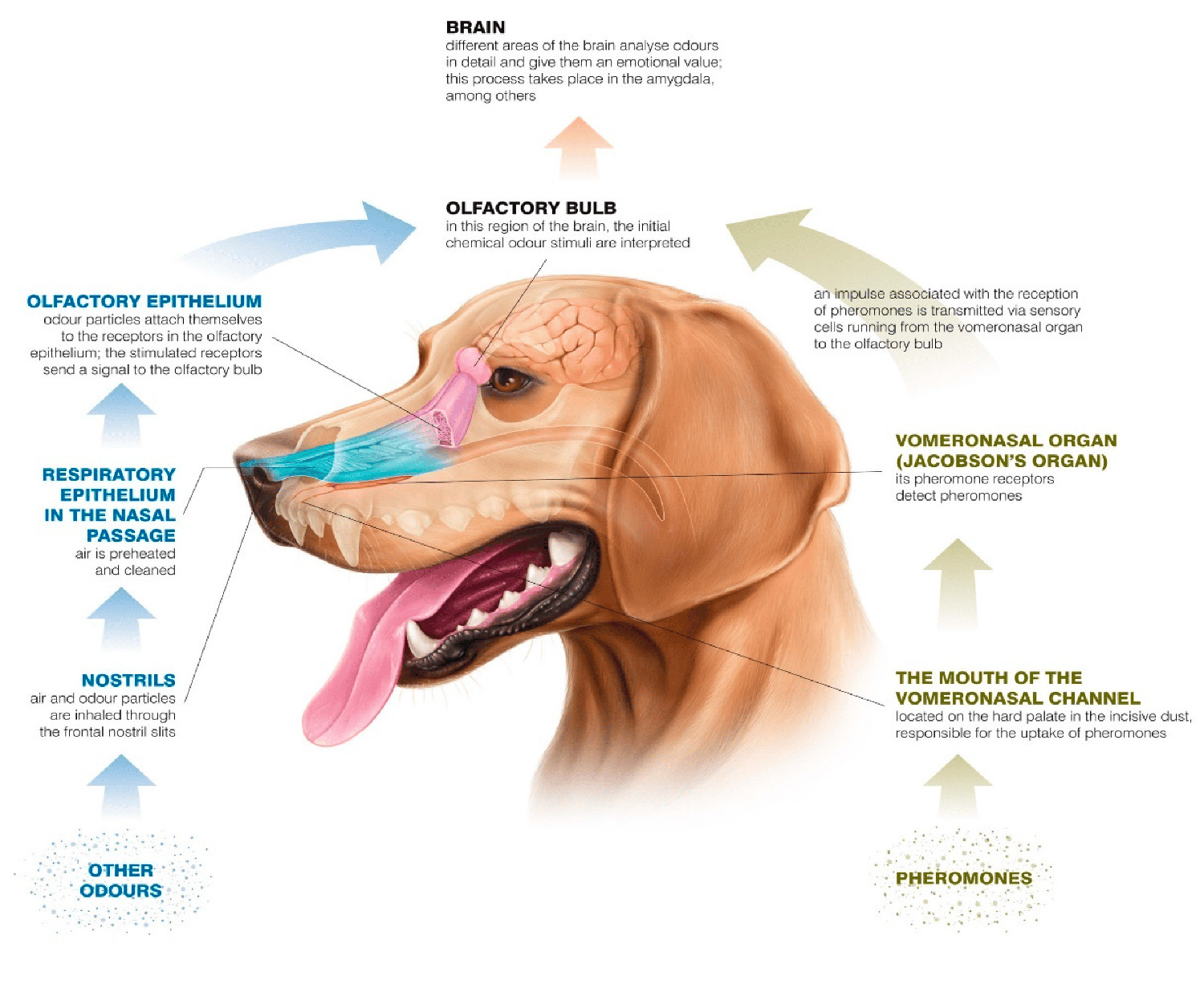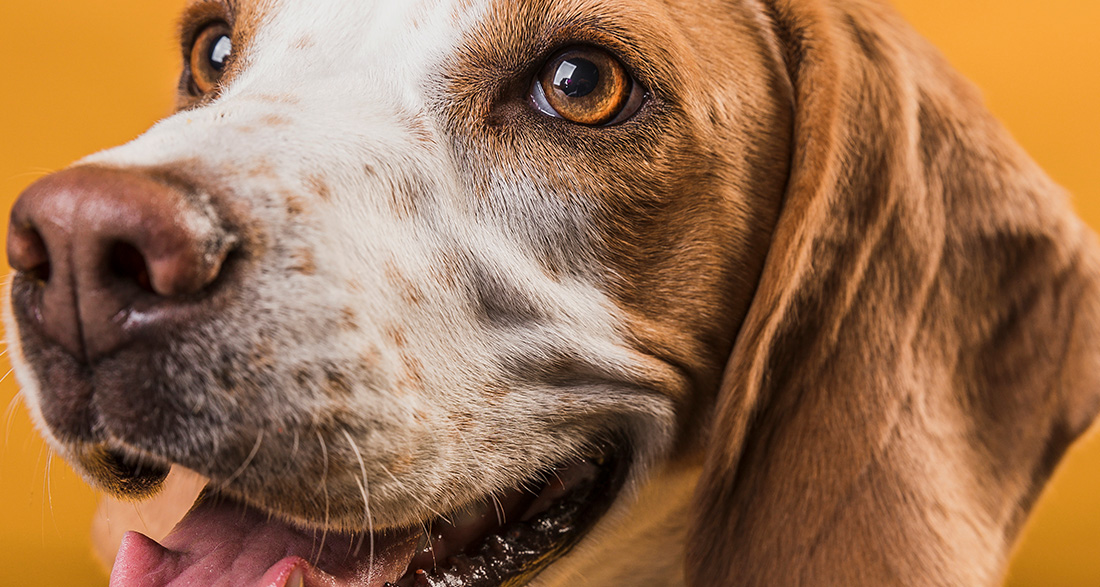Dogs are true masters when it comes to sniffing out scents. A dog’s nose is a highly sensitive organ, allowing them to perceive things that are almost inexplicable to us humans.
Dogs can pick up tracks over many kilometers, work as drug detection dogs, and discern our emotions based on scents. How does a dog’s sense of smell work? How do dogs perceive smells? What makes a dog’s nose so special?
How does a dog’s nose work?
In principle, the function of a dog’s nose is similar to ours. Odor particles enter the dog’s nasal cavity through the nostrils. The nasal cavity has glands that release moisture. The already inhaled air is cool and moist and is further enriched with moisture by the glands. The moisture, in turn, helps the odor molecules come into contact with the olfactory mucosa. The olfactory mucosa covers the nasal turbinates and contains olfactory cells that transmit scent particles to the brain. To prevent the necessary moisture from being lost, dogs need to drink a lot. A tracking dog takes about 250 to 300 breaths per minute during its work. This quickly leads to drying out of the olfactory mucosa, impairing its function.
For comparison: Humans have olfactory mucosa with a surface area of about five square centimeters. In dogs, depending on the breed, it can be up to 200 square centimeters. This also depends on the shape of the nose. While short-nosed dogs have fewer olfactory mucosa, long-nosed dogs have a significantly better sense of smell. The size of the dog also plays a role: Dachshunds and German Shepherds both have long noses. However, the German Shepherd has twice the surface area of olfactory mucosa compared to the Dachshund. Therefore, German Shepherds are often used as tracking dogs or drug detection dogs.

Special features of a dog’s nose
Dogs have an additional olfactory organ, the so-called Jacobson’s organ. This is located on the palate behind the dog’s incisors and is used for perceiving pheromones. With this organ, dogs can essentially sniff out our emotional state and react particularly to female dogs in heat. The breeds with the best noses include:
- German Shepherd
- German Shorthaired Pointer
- Labrador Retriever
- Pointer
The undisputed number one among sniffers is the Bloodhound, also known as the St. Hubertus Hound. It has 300 million olfactory cells, while other sniffers among dogs have about 225 million olfactory cells.
How far can a dog smell?
The dog’s nose allows it to track smells over long distances. Mantrailer dogs are trained to follow human tracks – whether in the search for missing persons or fleeing criminals. A DNA sample is sufficient for the dog to fixate on the person. It is possible for dogs to pick up a trail over a distance of up to ten kilometers and follow it accurately. The dog’s nose can not only track smells over long distances but also through matter. Trained search dogs can sniff out money hidden in concealed safes behind a wall paneling. Similarly, dogs can detect smells underground when searching for people. The olfactory capability reaches up to eight meters below the ground. In snow-covered areas, such as in the search for avalanche victims, it is up to three meters.
Can Dogs Perceive Human Emotions?
The dog is man’s best friend, not only because it is an ever-faithful companion but also because it can analyze our emotions. This doesn’t just happen through eye contact, as one might think. The typical Dachshund look may convey that our dog is currently wondering about something in humans. However, it is more about the dog’s nose that picks up on our emotions. The communication between a dog’s nose and brain plays a significant role here. Humans use about one percent of their brain capacity for smelling. In dogs, it’s ten percent. This leads to a conversion process between the nose and the brain, giving dogs the ability to spatially perceive smells.
Humans emit various scents with their feelings. Fear, anger, or sadness express themselves olfactorily in different ways. Your dog senses this and can smell how you are feeling.
By the way, communication among dogs often takes place through the sense of smell. The released pheromones provide a lot of information about another dog’s age or gender. Female dogs emit significantly more pheromones when in heat. A significant portion of the scents that dogs send out is through urine. Hence, it’s not surprising if your dog sniffs around every tree. For dogs, such a tree is like a WhatsApp group for you.
Can Dogs Smell Diseases?
There is a widespread belief that dogs can sniff out diseases. Certain dog breeds are specifically trained to smell an impending epileptic seizure or a sugar shock. However, the scientific process in which this occurs in dogs is not yet understood. Nevertheless, it is established that dogs can detect many diseases, including cancers, with their sense of smell. Researchers found that dogs can smell if a person has cancer based on their blood. The accuracy rate for cancers such as lung cancer, colorectal cancer, or breast cancer was over 90 percent.
The Super Nose – Disease Alert Dogs
Various dog breeds are trained as assistance dogs due to their smelling abilities; they serve as diabetic alert dogs or epilepsy alert dogs and undergo training that can last up to two years. They then become recognized assistance dogs. These dogs can warn their owners of health hazards by perceiving trained smells. They are even trained to fetch items such as emergency medications or a phone for emergency calls.
Moist Nose – Healthy Nose?
Many dog lovers believe that a healthy dog must have a wet nose. This is not necessarily the case. There are plenty of reasons why a healthy dog may have a dry nose occasionally. This can happen due to:
- Generally high temperatures with low humidity
- Dog exertion – which causes sweating and temporarily dries the nose
- Dry indoor air during the heating season
- Mild sunburn
The reasons for a dry nose are often harmless. Nonetheless, keep an eye on your dog’s sense of smell. If your dog’s nose is frequently dry, watch for symptoms such as pain, weakness, loss of appetite, or fatigue. In such cases, there might be something more significant, and you should consult your vet. Additionally, observe the following symptoms related to a dog’s nose:
- Change in nose color – usually black to pink
- Regular discharge of nasal secretions
- Nosebleeds
- Cracked nasal skin
- Formation of crusts on the nose surface
Loss of the sense of smell
When a dog’s nose doesn’t work properly, dogs can indeed become depressed. The sense of smell influences the dog’s psyche. They experience the world through their nose. With increasing age, the loss of olfactory abilities gradually sets in.
You can counteract the loss of smell a bit. Train your dog’s nose as they age. Allow your dog sufficient time during walks to pick up on tracks, sniff around trees, or other dogs. Food search games can help, encouraging your dog to sniff out its food. Dogs are used to having a filled bowl in front of them regularly. With a bit of variation, you can keep training your dog’s sense of smell for a long time.


